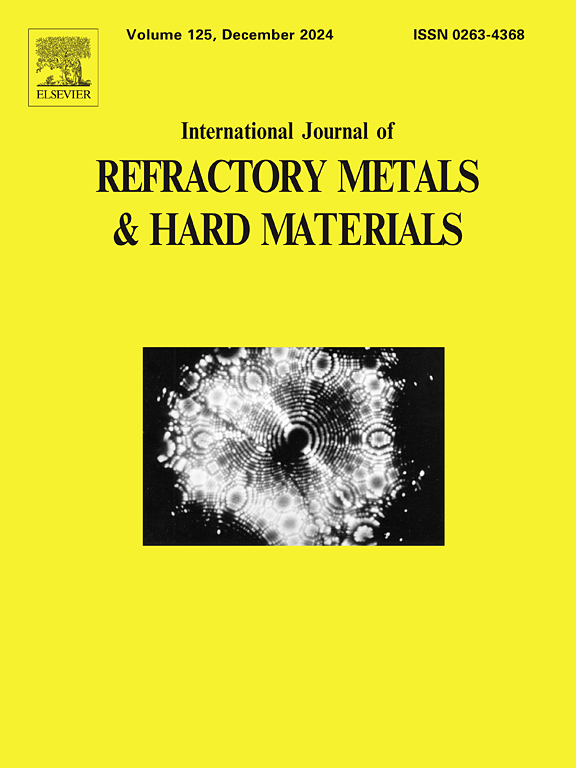IF 4.2
2区 材料科学
Q2 MATERIALS SCIENCE, MULTIDISCIPLINARY
International Journal of Refractory Metals & Hard Materials
Pub Date : 2025-04-09
DOI:10.1016/j.ijrmhm.2025.107182
引用次数: 0
摘要
耐火高熵合金的室温压缩塑性和高温强度倒置对实际应用提出了巨大挑战。本研究采用火花等离子烧结法制造了一种碳化物增强的 Ta-W 基中熵难熔合金。该合金具有出色的室温压缩塑性和高温强度。其微观结构由 BCC 基体和 M2C 碳化物组成,BCC 基体中分散着纳米级的 HfO2 颗粒。M2C 碳化物的尺寸为微米级,它们之间有可见的金属基体夹层。有效控制氧化物含量以及氧化物和碳化物的尺寸和分布,对于实现合金的优异塑性至关重要。在室温下,合金的断裂应变达到 20%,超过了通过电弧熔化生产的类似成分合金。此外,碳化物的强化作用显著提高了合金的高温强度,使其在 1750 °C 时的屈服强度达到 352 兆帕,极限抗压强度达到 426 兆帕。然而,由于碳化物的特定成分和空间特性,其强度略低于成分相似的电弧熔化合金。这项研究成功证明了制造碳化物增强耐火合金的可行性,这种合金兼具较高的室温压缩塑性和较强的高温性能。所提出的方法为大规模生产耐火合金部件提供了一种前景广阔的方法,凸显了其实际应用的潜力。本文章由计算机程序翻译,如有差异,请以英文原文为准。
Microstructure and mechanical properties of carbide-reinforced Ta-W-based refractory medium-entropy alloys prepared by spark plasma sintering
The inversion of room-temperature compression plasticity and high-temperature strength in refractory high-entropy alloys poses a significant challenge for practical applications. In this study, a carbide-reinforced Ta-W-based refractory medium-entropy alloy was fabricated using spark plasma sintering. The alloy exhibits outstanding room-temperature compression plasticity and excellent high-temperature strength. Its microstructure consists of a BCC matrix with M2C carbides, with nano-scale HfO2 particles dispersed within the BCC matrix. The M2C carbides are micron-sized, with visible metal matrix interlayers between them. Effective control over the oxide content, as well as the size and distribution of the oxides and carbides, is crucial for achieving superior plasticity in the alloy. At room temperature, the alloy achieves a fracture strain of 20 %, surpassing similar composition alloys produced by arc melting. Furthermore, the strengthening effect of carbides significantly enhances the high-temperature strength of the alloy, resulting in a yield strength of 352 MPa and an ultimate compressive strength of 426 MPa at 1750 °C. However, due to the specific composition and spatial characteristics of the carbides, its strength is slightly lower than that of arc-melted counterparts with similar compositions. This study successfully demonstrates the feasibility of fabricating carbide-reinforced refractory alloys that integrate high room-temperature compression plasticity with strong high-temperature performance. The proposed method offers a promising approach for the large-scale production of refractory alloy components, underscoring its potential for practical applications.
求助全文
通过发布文献求助,成功后即可免费获取论文全文。
去求助
来源期刊
CiteScore
7.00
自引率
13.90%
发文量
236
审稿时长
35 days
期刊介绍:
The International Journal of Refractory Metals and Hard Materials (IJRMHM) publishes original research articles concerned with all aspects of refractory metals and hard materials. Refractory metals are defined as metals with melting points higher than 1800 °C. These are tungsten, molybdenum, chromium, tantalum, niobium, hafnium, and rhenium, as well as many compounds and alloys based thereupon. Hard materials that are included in the scope of this journal are defined as materials with hardness values higher than 1000 kg/mm2, primarily intended for applications as manufacturing tools or wear resistant components in mechanical systems. Thus they encompass carbides, nitrides and borides of metals, and related compounds. A special focus of this journal is put on the family of hardmetals, which is also known as cemented tungsten carbide, and cermets which are based on titanium carbide and carbonitrides with or without a metal binder. Ceramics and superhard materials including diamond and cubic boron nitride may also be accepted provided the subject material is presented as hard materials as defined above.

 求助内容:
求助内容: 应助结果提醒方式:
应助结果提醒方式:


